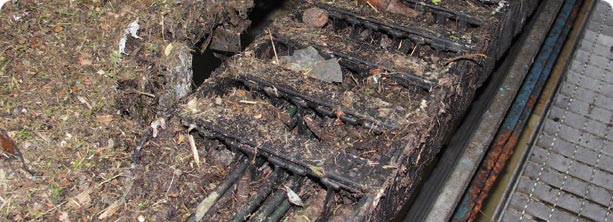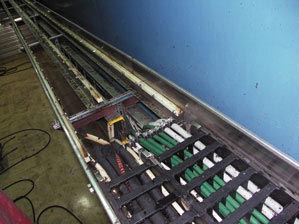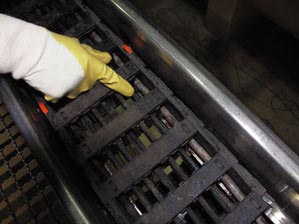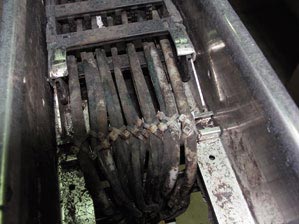igus® under discussion with engineer Werner Kretzinger, the maintenance manager, electrical engineering division, AVA Abfallverwertung Augsburg GmbH.

"We have extreme conditions on site"
Roller energy supply systems for a composting plantHeat, abrasive dirt, high atmospheric moisture: these are only some of the ambient conditions in a composting plant.
Every single component should stand the test of time in this environment to prevent unnecessary machine downtimes.
The roller energy supply systems have been in operation successfully since 2 years. The service life could be extended from one to five years.
Since the start-up of the composting plant, the energy supply systems have been in operation in the layer rearranging unit, the so-called Wendelin, in various lengths and versions of the igus® GmbH, Cologne. "And since then we've been modifying it", explains engineer Werner Kretzinger, maintenance manager of the electrical engineering division of the AVA Abfallverwertung Augsburg GmbH. "Whereas earlier the plant manufacturer recommended an urgent replacement every year, nowadays we participate in the technical advancement of the chains. "Since the time roller energy supply systems 'Rol-E Chain®' of the modular and rugged 'E4/4' system were used, a minimum durability of five years can be reckoned at the AVA.
From loppings to finished compost
From the aspect of 'ecological utilization - only the residual waste is burnt', a technically reasonable facility was created at the beginning of the 90s in 23.5 hectares of industrial land in 'Gewerbegebiet Augsburg-Ost'. It consists of a waste cogeneration plant with a flue gas cleaning system and a slag preparation plant, as well as a hospital waste incineration plant, a composting plant and a sorting plant. Around 240 employees are employed here.
In the composting plant, quality compost is made from organic and garden wastes as well as other biodegradable wastes. After the delivery and the coarse treatment, the materials arrive at the rotting hall where the actual composting process takes place. With the aid of the layer rearranging unit, the Wendelin, the piles are transferred, whereupon the material is respectively shifted from the insertion field to the discharge field by a pile section. "Our Wendelin rearranges the compost, so that biological processes can take place," explains Werner Kretzinger. According to the stage of degradation and degree of rotting, singular conditions develop in the separate pile sections with regard to biopopulation, metabolism, temperature and moisture. After few weeks, in which the material is aerated according to requirement and moisturized especially in summer, the actual composting process is completed.
Organic acids and high temperatures
"It takes at least a year for organic waste to become compost in one's own garden. We produce that in approximately 10 weeks," says Werner Kretzinger.
However the ambient conditions in the composting plant are extreme. The organic waste rots in an enclosed hall. It becomes damp and hot. Temperatures till 40°C and an atmospheric moisture of nearly 100% are common. Entry is allowed only with a face mask during operation.
Moreover there are all sorts of substances in the air which influence the procedure. In an exploratory analysis, clear concentrations of ammonia and organic acids were found in the air in the rotting hall. Slimy biofilms have formed on all surfaces like, for example, on the energy supply systems. The pH values on these surfaces are about pH 5. "We cannot use steel in the rotting hall. Only V4A stainless steel withstands the conditions on site," say the maintenance manager.
As coarse materials like tree and shrub cuts are mixed in the organic waste, there is highly abrasive additional input which acts most notably on the E-Chain® systems. "The plant is in operation day and night, so that the demands on the durability of the components are extremely high," clarifies Werner Kretzinger.

Rugged stainless steel trough
Roller energy supply chain in extreme application
The rotting hall is 135 meters long and 60 meters wide, which corresponds approximately to the travel length of the Wendelin. Its speed amounts to 0.1 m/s. It has a longitudinal chain and a cross chain. In addition, two other chains are at the input for conveying and distributing the organic waste in the first pile. "We have two rearranging systems, so that overall eight energy supply systems are at work," reports Herbert Merk, the factory manager, electrical engineering division, responsible for the plant inspections and maintenance works.
The maximum loads are at the cross chain, because the Wendelin continuously enters the rotting process. The longitudinal chain travels only section-wise.
There are ten rotting fields in total. Whereas the gliding energy supply systems are still used in the longitudinal travel, the roller energy supply systems are solely used otherwise. "Though they have been in operation for over two years, they don't show any sign of wear at all," reports Werner Kretzinger. "The energy supply systems are tested every month. We generate a test report for every measurement. Here we can observe that no abrasive wear has taken place so far. "

The carefully laid cables and media hoses are easily recognizable. Separators guarantee that there are no slips.
And Herbert Merk adds: "The roller energy supply systems have another advantage. They need not be watered for better movement. In the beginning we thought the rolling will be hindered by the weight of the encased cables, water and hydraulic hoses, but they roll quite well through the slimy components of the organic waste without being pasted over. "
Besides the roller energy supply systems, Chainflex® cables, guide troughs for the long travel as well as separators and strain relief systems from the company igus® are also in operation. The SAG GmbH, Landshut, operates as partner of the AVA in Augsburg for energy technology infrastructure. In charge for inspections and rebuilding, particularly in the rotting hall, they are most familiar with the energy supply systems.
"We have for example modified the entire cable separations and optimized the strain relief systems due to our experience on site in the course of time," reports the SAG employee in charge, Walter Eisch. "And with it a long durability of the energy supply systems was already taken care of"
Werner Kretzinger adds: "The plant constructor for example did not consider several details in the laying of the cable. They must be laid in such a way that the load distribution runs uniformly within the energy supply system. Moreover adequate separators should be used. These are relatively small cost factors, but have a great effect on the functionality of the entire plant. We cannot afford a chain with a subsequent cable break. "
Rolls instead of glides

Roller energy supply system in the guide trough. The rollers are easy to recognize.
Conventionally designed E-Chain® types are operated in the glide mode on long travels. The reason for developing the 'Rol E-Chain®' has been the necessity to extend the technical limits of this operating mode. They show off their overall advantage in long travels, high speeds as well as high cable loads. "Whereas they glided on each other earlier, now they roll on each other," explains Michael Offner, Manager of Customer Engineering division, southern Germany, igus®. "It means the drive forces is reduced by 75%. The coarse and very crude dirt particles particularly in this plant generally lead to increased abrasion. In smoothly rolling operation mode, the rolling resistance is minimized and therewith the wear of the chain. Their service life increases significantly. "
Each chain link has a so-called "tongue and groove" in the subsequent link. Thus ultimately a labyrinth seal forms which extensively protects the stop dog system and the pins from dirt accumulation. This seal is also found if the roller is pulled out from the chain link. Thus the penetration of dirt is prevented in this position as well. The life-long lubricated stainless steel bearings are additionally sealed up.
"Today we have solely roller energy supply systems on site as replacement. They are stored in the delivery hall near the rotting hall, so that they get adapted to the extreme application conditions from the start. Or else there is the danger of sudden ripping," explains Werner Kretzinger. "The conditioning of the energy supply system in the most varied application conditions can also be conducted by us in the factory," clarifies Michael Offner. This is not possible at the AVA in Augsburg due to the quick response times in the event of repairs.
Control cables for higher service life
The application conditions in the composting plant influence not only the energy supply systems, but also the cables responsible for the supply. "If they become brittle and the dreadful corkscrewing occurs, the main supply line of the Wendelin snaps and the entire plant comes to a standstill. For this reason we also procure the cables from the company igus® since 1999," reports Werner Kretzinger.
The 'Chainflex® CF 5' unshielded control cables are used on site. By its structure, with gusset-filling pressure extruded inner jacket and the PVC outer jacket, the series is suitable for heavy-duty use. "We have overall increased the service life of the rearranging facilities by the cables and the E-Chain® systems," clarifies the factory manager.
Comparison of two systems

An igus® employee introduced the roller energy supply system while on a visit. Developed for, among other things, applications in particularly dirty ambience, their advantages were quickly perceived at the AVA. "And the development hasn't stagnated from the first roller chain till the present model," clarifies Michael Offner. "The distance of the individual rollers has been shortened and once again aligned to the hard conditions on site. "The customer requirements are therewith directly included in the product development.
"At that time we immediately ordered for a chain for the next revision," says Werner Kretzinger. "And we could compare the two systems. The technical advantages of the roller energy supply system was apparent to us pretty fast. Today we have one more gliding energy chain in application, which will be the last to be replaced next year." It is certain that the roller energy supply systems in the composting plants of the AVA Augsburg will last for at least five years. Therewith the service life goes up five times.
"It is a full-time job to keep the energy supply systems alive in this ambience," points out the maintenance manager at the end. "However we recognize from the monthly measurements and annual inspections that we weren't promised too much. "The investment pays off.
Author: Michael Offner, Manager of Customer Engineering division - southern Germany, igus® GmbH, Cologne